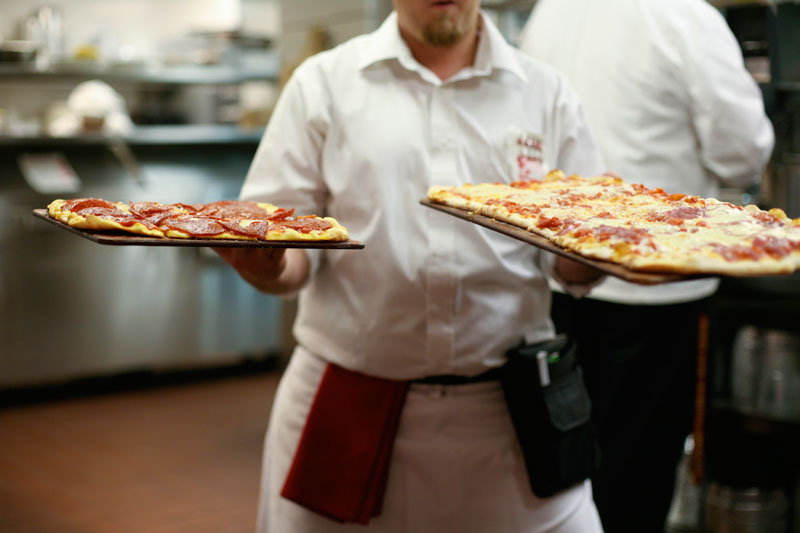Pizza is like sex, the old joke goes: When it’s good, it’s great, but when it’s bad, it’s still pretty darn good. Then there are those free thinkers who, all joking aside, say pizza is better than sex. In a 2015 survey by gluten-free crust purveyor Smart Flour Foods and the Center for Generational Kinetics, more than 6 million adults said they would give up sex for a year before they’d stop eating pizza. Now that’s what we call pizza power.
The Smart Flour Foods study, titled Pizza Lovers in America 2015: Unexpected Findings From a Generational Look at Pizza Trends, was packed with intriguing revelations. It found that 35% of Americans go out for pizza and buy grocery-store pizza at least once per month, but these people—termed “pizza lovers” in the study—defy old stereotypes. Forget frat boys, gamers and beer-bellied football fans. Think fit young ladies. The study found that 63% of pizza lovers are women, and 41% of those women are millennials (as defined by the study, born between 1977 and 1995). Sixty-eight percent of all pizza lovers exercise two or more times per week. More than half (53%) are ages 25 to 44, while only 8% are 65 or older.
In other words, the typical hardcore pizza fan may not be who you think “he” is. He’s a she, she’s relatively young, and she’s health-conscious. She loves her mobile phone (possibly more than sex and pizza combined) and uses it for everything from texting and watching videos to ordering pizza and posting pictures of that pizza online. And she is a brown-eyed brunette with a mole on her left shoulder—OK, we made that part up. But you get the picture.
Before long, that “typical” pizza fan won’t even be white. As a recent study from research firm Mintel shows, Hispanic, black and Asian populations are growing faster than whites. The Hispanic population is predicted to grow by nearly 27% between 2009 and 2019, and Hispanic households will have more kids. Lucky for us, as Ad Age reported in 2014, Hispanic consumers “are more likely to choose pizza when they go out for fast food as compared to the general market.”
As sure as the earth keeps spinning, the pizza market keeps evolving. Unfortunately, as we’ll learn, it doesn’t always keep growing.
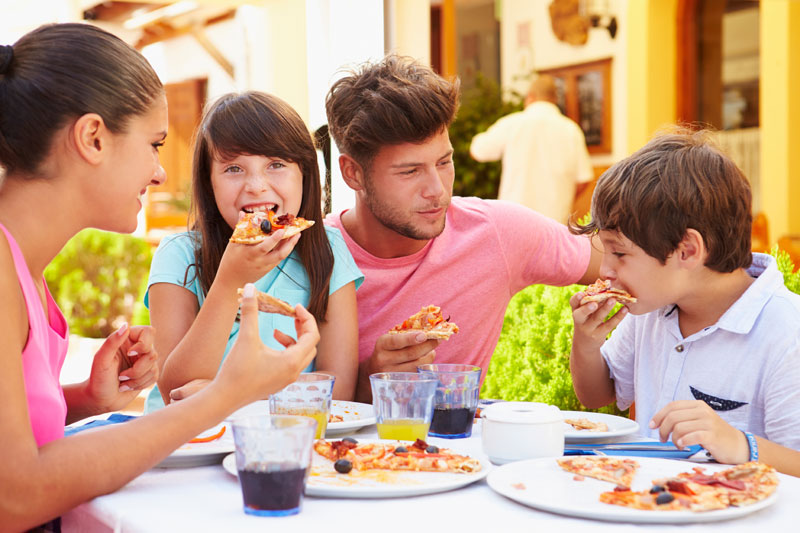 |
|
Hispanics, whose population is predicted to grow by nearly 27% between 2009 and 2019, are more likely to choose pizza when they go out for fast food than the general market. They also have larger households with more children. |
Bad News for Independents
This year’s pizza sales numbers from research firm CHD Expert don’t look as promising as we’d like. Overall, pizza restaurant sales in the United States were flat for the year ending September 30, 2015, even while the total number of units increased. Pizza sales reached $38,504,164.116, a slight drop of .05% from the same time period in 2014. Average store sales also went down to $514,679, a
decrease of 2.34%.
A closer look at the past year’s sales figures from CHD Expert reveals some particularly discouraging news for independent operators (those with fewer than 10 stores). Their sales dropped by 5.01% to a total of $14,967,292,162, while chain operators (10 or more units) logged an increase of 3.38% to $23,536,871,954. Independents’ average sales dropped by 3.21% to $384,524 per store, while the chains saw an increase in average sales of 3.82% to $655,846. The chains also added more units, with a 7.33% increase to a total of 35,888 stores, even as more independent stores closed their doors, dropping to 38,924, a decrease of 1.85% from the previous year.
All of this points to a shrinking market share for independent pizzerias—they now account for a little under 39% of all pizza sales, compared to slightly more than 61% for the chains. That’s about a 2% drop compared to the same period in 2014.
What accounts for this downturn in business for independent operators? We can only speculate, but it’s a safe bet online ordering has a lot to do with it. Smaller independents have been slow to adopt mobile ordering technologies, while the big chains—and many of the smaller ones—acted quickly and decisively. About 50% of Domino’s (dominos.com) sales now come through its digital ordering channels, and studies show that online customers tend to spend more on their orders. Plus, as Domino’s CEO J. Patrick Doyle told investors in late 2014, digital ordering leads to a higher volume of orders from repeat customers.
In short, if your customers can’t place orders online, you’re falling behind.
Rolling Right Along
Overall, the restaurant industry keeps rolling along.
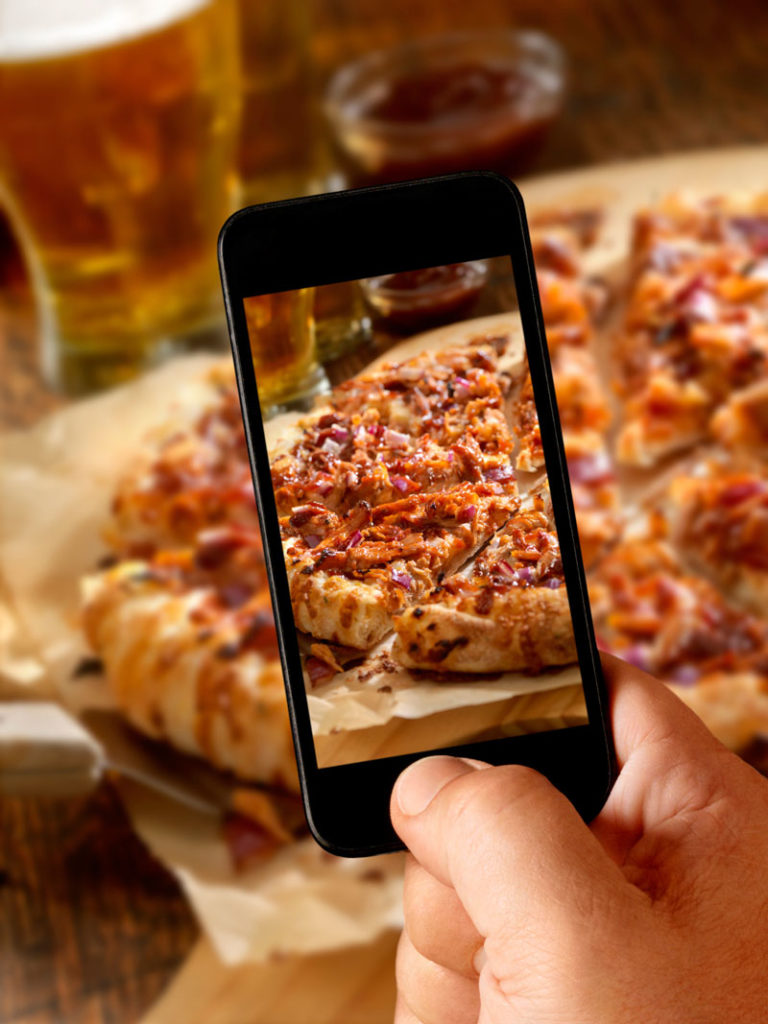
According to the National Restaurant Association (NRA) 2015 Restaurant Industry Forecast, restaurant sales should hit a record high in 2015, soaring to $709.2 billion, a 3.8% jump from 2014. The NRA report attributes the growth to a strengthening economy but adds that “the gains remain below what would be expected during a normal post-recession period.”
That caveat aside, 2015 will represent the industry’s sixth straight year of real sales growth. It will continue to outpace total U.S. job growth in 2015, employing a projected 14 million people in 1 million locations, and will add another 1.7 million new jobs over the next decade. Restaurants also earn 47 cents of every food dollar spent in the country—compared to 25 cents back in 1955.
The NRA report predicts modest sales growth of 4.3% for quick-service and fast-casual restaurants. Fifty-nine percent of quick-service restaurants are projected to enjoy higher sales and profitability in 2015, while 36% will experience little or no growth, and 3% will see a decline. The numbers look similar for fast-casual stores, 62% of which should experience sales and profitability growth, while 33% will stay the same, and 5% will experience a decrease.
Millennials: A Generation of Foodies
| What’s a Millennial, Anyway? |
| Millennials are unlike any generation before them. At least, that’s what marketing professionals have been telling us for years now, and they may be right. But what they can’t seem to tell us for sure is, exactly what is a millennial? In their study, Pizza Lovers in 2015, quoted throughout this year’s Pizza Power Report, Smart Flour Foods and the Center for Generational Kinetics describe millennials as the generation born between 1977 and 1995. Research firm Technomic has a slightly different definition—those born between 1977 and 1992. Another research firm, Mintel, simply says millennials “are between the ages of 21 and 38,” which comes out to a birth date range of 1997 to 1994. |
He’s a foodie, she’s a foodie, you’re a foodie, I’m a foodie—an ever-growing love of good food may be the one thing Americans have in common these days, and that bodes well for the pizza industry. A 2013 study by advertising firm BBDO found that nearly 50% of millennials call themselves “foodies.” Members of this fast-rising generation don’t just eat their food—they engage and connect with it, seeking out new, more intense flavors, extreme textures, and ethnic and artisan dishes. They experience it and then record that experience with a snapshot on their smartphones and a quick post to Instagram.
Of course, millennials don’t have the foodie market cornered; they share it with baby boomers, many of whom also self-identify as foodies. But millennials are poised to take over the world: They already comprise more than half of the labor market and will likely start outspending baby boomers in the next several years. According to Mintel, millennials are projected to account for 30% of all U.S. retail sales by 2020. In short, every pizzeria operator needs to keep this customer demographic in mind if he wants to grow his business. “The tidal wave of 80 million millennials now entering the U.S. pizza market has created a host of new challenges and opportunities,” notes the Smart Flour Foods study. Millennials have their own way of making purchasing decisions and ordering pizza—they rely on their smartphones, often don’t carry cash, and have “the least established brand loyalty” of any generation today. But they’re not necessarily disloyal, the study’s authors conclude. “Millennials are hugely loyal to brands and restaurants to which they feel a connection, but many millennials simply haven’t established that loyalty yet.”
That’s in part because many millennials feel suspicious of corporate brands and place a high premium on authenticity. This means independent pizzerias that emphasize their hometown roots and owner-driven personalities may have an advantage in competing for millennials’ spending dollars. But to get their attention, you will have to move beyond traditional print advertising and direct mail and incorporate online ordering, the latest social media platforms (not just Facebook, which has faded with the younger crowd) and mobile technologies into your marketing plan. The Smart Flour Foods study reports that nearly ⅓ of millennials “use online advertising, social media and online ratings to gain pizza information versus less than 20% for those 35 and over.”
Fast Casual: We’ve Only Just Begun
We hate to repeat ourselves every year, but fast-casual is still big, and it’s getting bigger. Nation’s Restaurant News (NRN) hailed it as “the growth engine of the U.S. restaurant industry,” noting the segment has expanded 550% since 1999 and raked in $30 billion in sales in 2014. NRN forecasts continued growth “in the double digits through 2022, while the rest of the restaurant industry is predicted to only eke out half a percentage point.”
Unfortunately, few experts agree on exactly what “fast casual” means—if anything, the definition seems to be evolving, and the line between fast-casual, fast-food and table-service dining has become blurred.
Media observers say fast-casual is mostly about fresher, better ingredients, a higher degree of customization and a higher price point (ranging from $9 to $13 per check compared to an average ticket of $5 or less for fast food). But try telling that to a traditional independent pizzaiolo and watch his eyes pop out of his skull—he knows he’s been offering fresh ingredients and build-your-own options for decades!
Even so, fast-casual is a buzz term that grabs attention, especially in sit-downs with private equity firms. “Fast-casual pizza is the fastest-growing segment in the restaurant business,” says Sean Brauser, founder of the traditional Romeo’s Pizza (romeospizza.com) chain as well as Pizzafire (pizzafire.com), a new fast-casual concept with locations in Akron and Cleveland, Ohio. “We have grown [Pizzafire] to $5 million in just over a year, and we plan on opening 12 to 18 more stores next year.”
Brauser says Pizzafire doesn’t vie with traditional pizzerias for customers’ cash. “We compete with Chipotle, Jimmy John’s and Panera Bread,” he says. “And because of that, sales volumes are significantly higher. Our buildouts are all below $200,000, and our projected net profit is $180,000 per store. That’s 100% ROI, and that’s what we are selling to our private equity guys.”
Brauser likens the burgeoning fast-casual segment to the “wild west”—an arena that favors the brave and the bold, where you’ve got to be quick on the draw and your aim must be true. Several leading gunslingers have emerged, including Pieology (pieology.com), the first fast-casual pizza company to crack Technomic’s annual ranking of the 500 largest restaurant chains. Pieology’s systemwide sales totalled nearly $45 million in 2014, an increase of 230% over the previous year, and a unit increase of 180%. MOD Pizza (modpizza.com) and Pie Five Pizza (piefivepizza.com), meanwhile, both doubled their sales in 2014, while PizzaRev (pizzarev.com) nearly tripled its sales and number of stores, according to Technomic.
Brauser hopes to move Pizzafire into that upper echelon. “Our strategy is to go to an area and dominate it with eight to 10 locations within a three-year period,” he says. “We feel the competitive advantage of being first [in a given market] will allow us to grow faster and stronger than other brands.”
Still, the top pizza chains haven’t been noticeably hurt by the fast-casual boom. As Darren Tristano, Technomic’s executive vice president, noted in a blog, Domino’s, Little Caesars (littlecaesars.com) and Papa John’s (papajohns.com) have all gained market share. The Domino’s share went from 17.7% to 18.8%, while Little Caesars rose from 14.4% to 14.7%, and Papa John’s grew from 11.7% to 12.2%. Pizza Hut (pizzahut.com) was the notable exception, losing 1.7% of market share, but still leading the pack with 25.1%. “Why aren’t the fast-casual chains eating Domino’s and Papa John’s lunch at the moment?” Tristano writes. “Mostly because the traditional chains are not focused on lunch the way fast-casual brands typically are. The traditional pizza segment and the fast-casual sector are going after different pizza occasions, with the big national brands using their digital-ordering and advertising clout to go after dinner, group and delivery occasions, and fast-casual brands chasing the workday lunch crowd.
“In future years, this market share picture might change dramatically if more build-your-own pizza brands crash the Top 500,” Tristano concludes. “This fast-casual expansion story is familiar, if a little different, but it’s only just begun.”
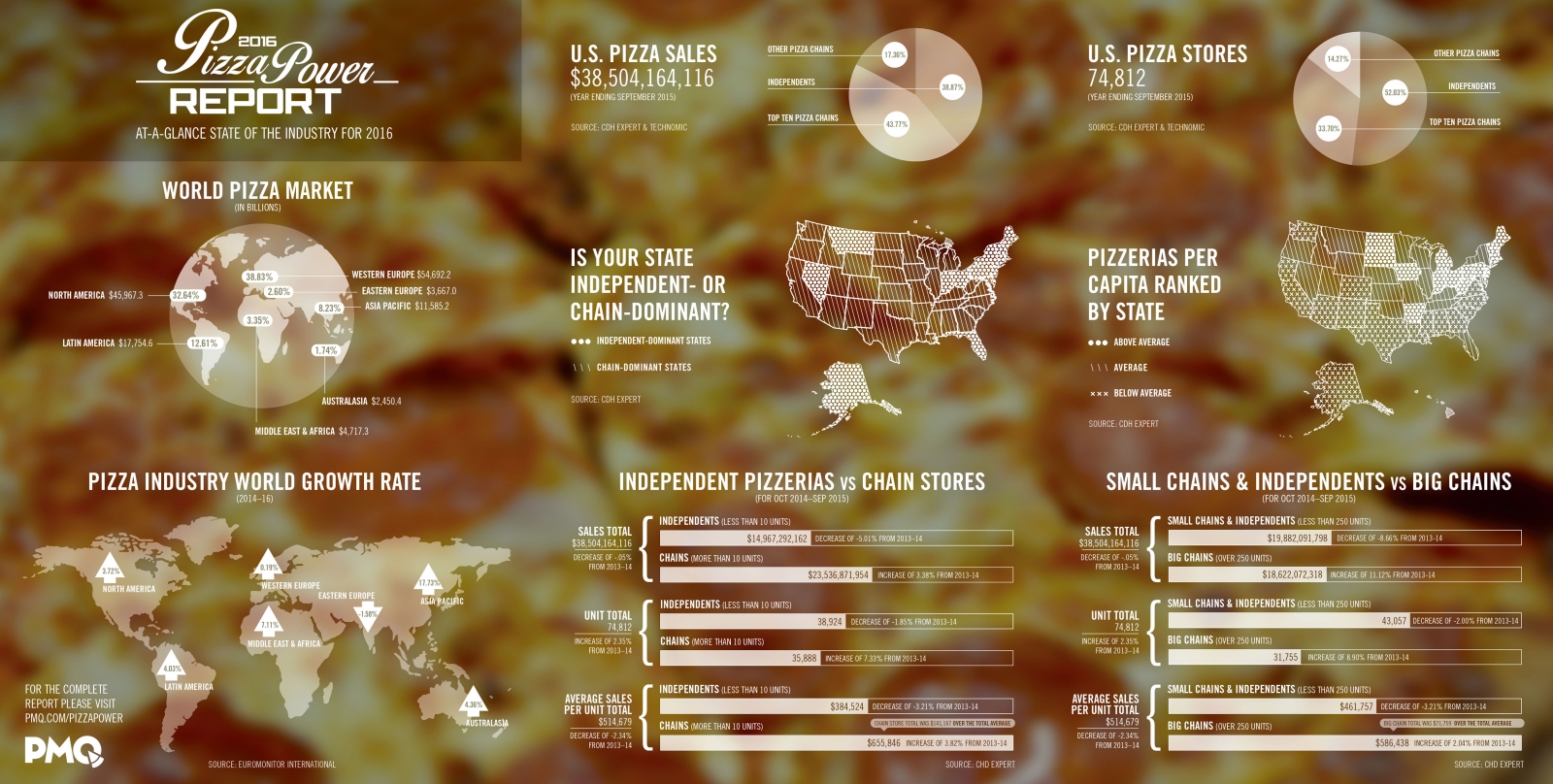 |
|
Click the above graphic to download a shareable “at-a-glance” infographic detailing the world pizza industry! |
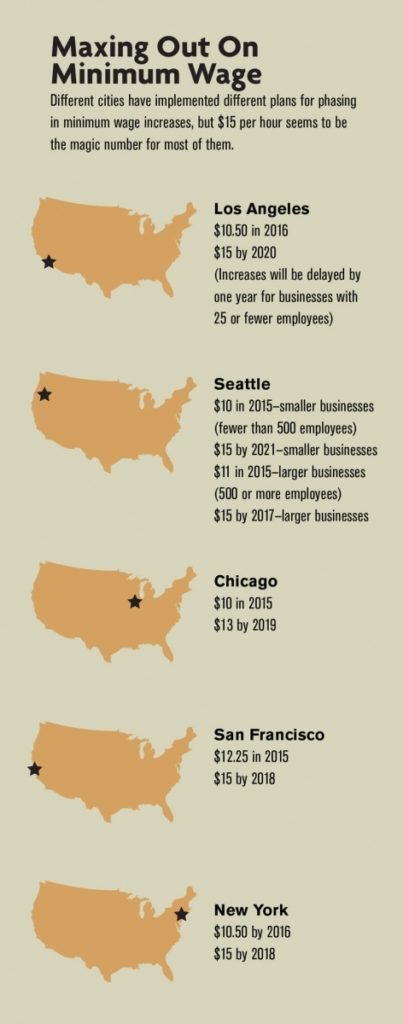 Wages On the Rise
Wages On the Rise
The battle over minimum wage is just getting started, too. The minimum wage is on the rise and will keep growing over the next few years in several major cities around the country. A boost in the federal minimum wage appears unlikely anytime soon, but that won’t be for lack of trying. President Obama has asked Congress to raise the minimum wage from $7.25 an hour to $10.10 an hour.
Few operators object to paying their employees a fair wage. But with profit margins already low in the restaurant business, increased labor costs could deliver a severe jolt to the bottom line. And that could translate to layoffs or reduced hiring, many owners warn. In Seattle, the minimum wage will be increased gradually to $15; the first increase, to $11 an hour, took effect in April. An October report by the American Enterprise Institute (AEI) found that restaurant employment in the Seattle area declined by 700 jobs between January and September 2015, even as total restaurant employment in the rest of the state increased by 5,800 new jobs. Does that mean Seattle’s minimum wage hike threw 700 people out of work? Not necessarily—the report covered a broad metropolitan area, not just the city of Seattle itself, and many surrounding communities included in the survey aren’t affected by the Seattle wage requirement. Still, economist Mark Perry, author of the AEI study, concluded the higher minimum wage is “one likely cause” of the decline in Seattle restaurant employment.
Wage increases may be a bitter pill to swallow, but they’re part of the cost of doing business, says Jeff Mease, owner of Pizza X (pizzaxbloomington.com), with four locations in Bloomington, Indiana. “Minimum wages are going to go up, and prices are going to go up,” he says. “And that’s probably a much more welcome problem than deflation. We should all stop whining and spend more energy creating a better customer experience and figuring out how we can charge more for it, then share the spoils with our staff, who create it.”
One obvious solution—raising prices—isn’t popular with some operators, but Mease doesn’t fret about it. “That concern about customers revolting due to price increases is largely imaginary,” he says. “In foodservice, I think we should always want some percentage of our customers thinking we are too expensive.”
Menu Labeling: A Matter of Crust
Chain operators with 20 or more stores have another year to incorporate calorie counts into their menus. New menu labeling rules, which stem from 2010’s Affordable Care Act, go into effect on December 1, 2016. The final guidelines, released by the Food and Drug Administration (FDA) this fall, require larger chains to provide calorie information on menus and menu boards, along with “a succinct statement about suggested daily caloric intake.” Other nutritional information—ranging from total fat, trans fat and saturated fat to carbs, sodium, fiber and more—must be made available to customers in writing upon request. Restaurants can offer daily or seasonal specials without providing a calorie count. Most importantly, companies with fewer than 20 stores aren’t required to offer any kind of nutritional information.
The law initially made pizzeria operators very nervous. Due to the sheer number of possible toppings and topping combinations, it would be nearly impossible to quantify the caloric value of every build-your-own pizza customers could order. Fortunately, the NRA’s Pizzeria Industry Council (PIC) pushed for common-sense guidelines and prevailed. Under the FDA’s final rules, most pizzerias can list calories by the slice as long as they state how many slices each whole pizza contains. They can also list a range of calories for build-your-own pizzas with varying toppings.
One sticking point remains, however, and it may be a doozy. Marla Topliff, chair of the PIC and president of the Rosati’s Pizza (rosatispizza.com) chain, says the FDA’s calories-by-the-slice allowance won’t apply to pizzerias that serve square-cut pies—or any nonround pizzas, for that matter. As the rules stand now, those pizzerias will have to declare an entire pizza as a single serving. According to industry nutritional consultant Betsy Craig, founder and CEO of MenuTrinfo, it comes down to a matter of crust. The FDA requires calories to be listed per “discrete serving unit,” which works fine for triangular-cut slices but not so well for party-style cuts. “Pizza slices that are uniform—like a wedge shape—on a typical round pizza can be considered ‘discrete serving units’ because those slices will all have roughly the same amount of crust, sauce, toppings, etc., while square slices will only be considered a ‘discrete serving unit’ if there is no crust,” Craig says. “That’s because the crust edges and corner pieces will have a much different nutritional makeup than, say, an inside square piece with no corners. Therefore, the corner and edge pieces cannot be listed by the ‘unit,’ and pizzerias will have to list the entire pizza’s caloric and nutritional numbers.”
In other words, any pizzeria that serves square or rectangular pieces—including Chicago-style square-cut, St. Louis-style, Detroit-style and grandma pies—would have to declare a calorie total for the entire pizza, not for individual pieces. “That means our pizza’s calorie count could be 3,000—because we have to count the whole pie—whereas Domino’s can be listed as 150 calories because they can count just one slice,” Topliff says.
Topliff and Craig have been pushing the FDA to set a standard serving size of 4.95 ounces for pizzas. “That’s what they use for packaged foods, and it would be, by far, the fairest solution, allowing the consumer to make choices with clear, simple and accurate information,” Craig says. “Do I think the FDA will change the rule? I truly hope so, for all of our clients that don’t have 10,000-plus locations and depend on the consumer being able to understand the information they present and choose local, independent and family chains first. I’m pulling for the FDA to listen to reason on this. A girl can dream.”
A Social Conscience
Call them hippies, call them liberals, call them what you will, but more and more consumers expect their favorite restaurants to exhibit a strong social conscience, especially in regard to the environment and sustainability. According to the Smart Flour Foods study, millennials in particular “have a natural resistance to companies they consider ‘corporate,’ those that don’t authentically commit to a purpose beyond earning money.” Another study, conducted by ad agency network TBWA/Worldwide in 2011, found that seven in 10 young adults consider themselves “social activists,” and 75% believe corporations should create economic value for society by supporting worthy causes. As Crain’s Chicago Business put it in a 2014 article, “Corporate social responsibility is the millennials’ new religion.”
And they’re not alone. In a 2014 Technomic study, 63% of all consumers said they would more likely eat at a restaurant they view as socially conscious. They tend to value safe working conditions for employees, recycling programs and reduction of food waste.
Yum! Brands, parent company of Pizza Hut, has committed to several environmental goals, including reducing energy consumption, lowering water consumption and using more paper-based packaging with fiber from responsibly managed forests and recycled sources. Meanwhile, many independents and small chains have built their brands in part around social responsibility. With its Field to Fork program, Fuel Pizza (fuelpizza.com), which has a dozen locations in North Carolina, South Carolina and Washington, D.C., partners with schools in Charlotte and Mecklenburg County to encourage healthy eating and create “pizza gardens” where teachers and students grow and harvest their own vegetables. And Mason Wartman, owner of Rosa’s Fresh Pizza (rosasfreshpizza.com) in Philadelphia, has earned national acclaim for keeping a wall of sticky notes with prepaid credits for pizza to feed the needy.
How to Compete in 2016
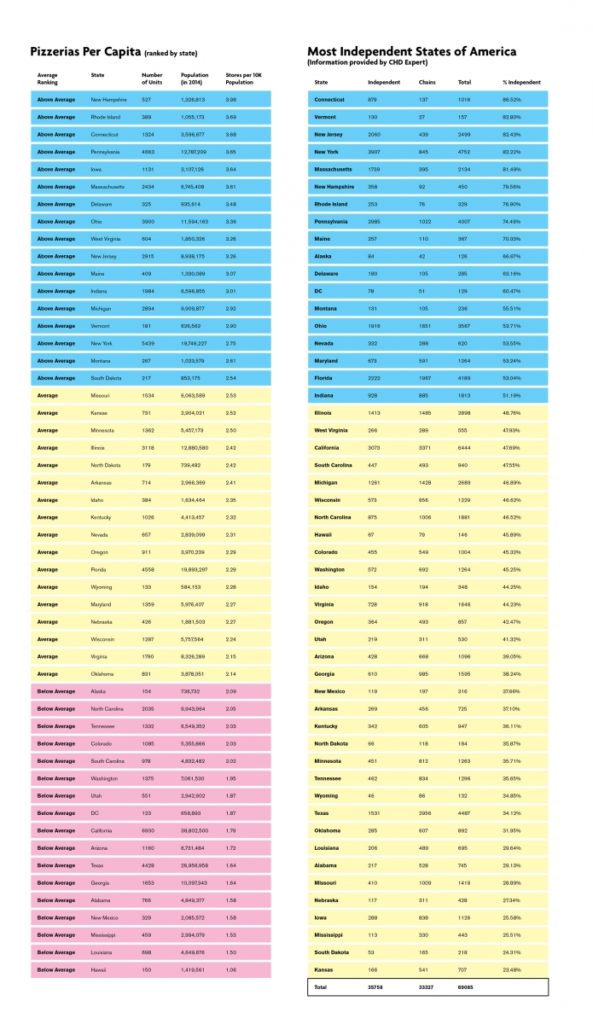 |
|
Click this graphic to see PMQ’s breakdown of pizzerias per capita and independent vs. chain market share by state. |
Give millennials what they want
Sounds easy, but Pizza Hut will tell you it’s no slam-dunk. The corporate giant’s “Flavor of Now” rebrand—replete with quirky customization options such as Peruvian cherry peppers and toasted Asiago crusts—famously bombed over the past year, even though it was crafted with millennials in mind. But remember, millennials don’t necessarily trust big-box companies. Most experts agree that offering increased customization with artisan toppings, sauces and crusts, plus an authentic commitment to improving your community, can help you court the millennial crowd and compete with the budding fast-casual giants of the world.
Embrace digital marketing and sales tools
We’re looking at you, old-school operators. More and more customers want to place their orders digitally, and if you don’t let them, Domino’s and other big-box competitors certainly will. These customers want to receive coupons and learn about specials via mobile devices. They use crowdsourcing websites and social media to decide where to eat. Their moms and dads may continue eating at your place, but this new generation of customers will look elsewhere if you can’t speak to them where they’re at—online and on their smartphones.
Raise your prices if you need to
Just do it. But don’t overdo it. “Raise your prices a little bit every year, and don’t raise everything at once,” Mease advices. “Here’s a lesson I learned a long time ago: If, as the owner, your ego gets involved too much and you find yourself resisting raising prices, even with rising food and labor costs, delegate repricing the menu—and do this annually—to someone else in your organization who is rewarded for profitability but who doesn’t have the same ego issues.”
Act naturally
More customers now avoid additives and what they perceive to be unhealthy ingredients. In the Smart Flour Foods study, 77% of pizza lovers said that natural ingredients are important to them. Twenty-nine percent avoid meats with added hormones, for example, and 28% shun high-fructose corn syrup.
Start offering delivery
Your new fast-casual competitor may have nailed the lunch-hour crowd, but it probably has one big shortcoming: It doesn’t offer delivery. Demand for delivery remains as high as ever, even if the ordering tools have changed. Offer a delivery option—and let customers order by phone, online and via smartphone app—and you’ve got a leg up on that fancy shop down the street.
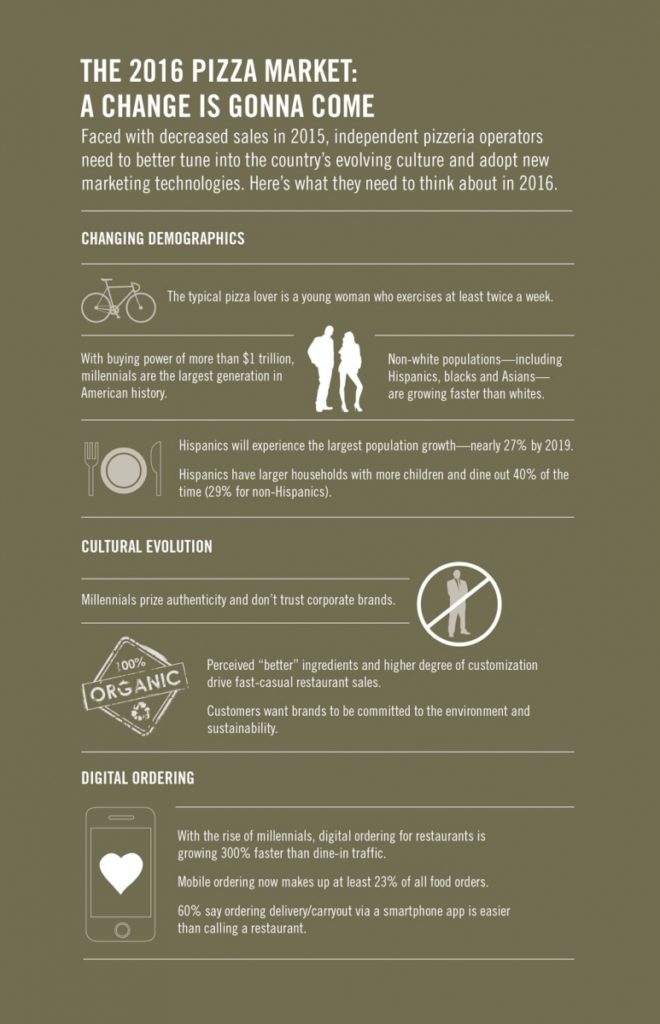 |
|
Click this graphic to download PMQ’s analysis of trends to watch for in 2016. |
 |
|
Click this graphic to download the top 50 U.S. chains by the numbers. |



